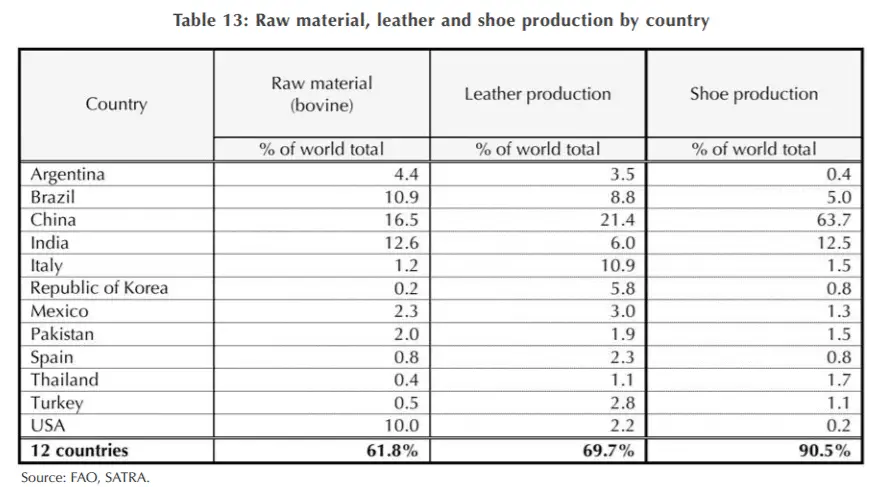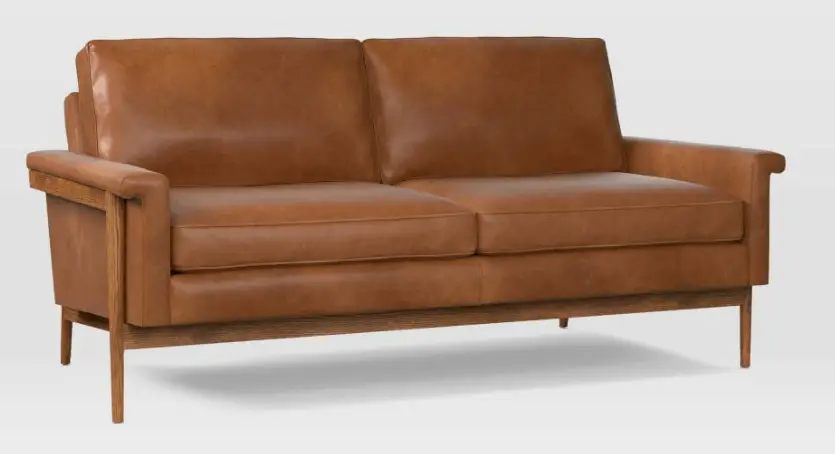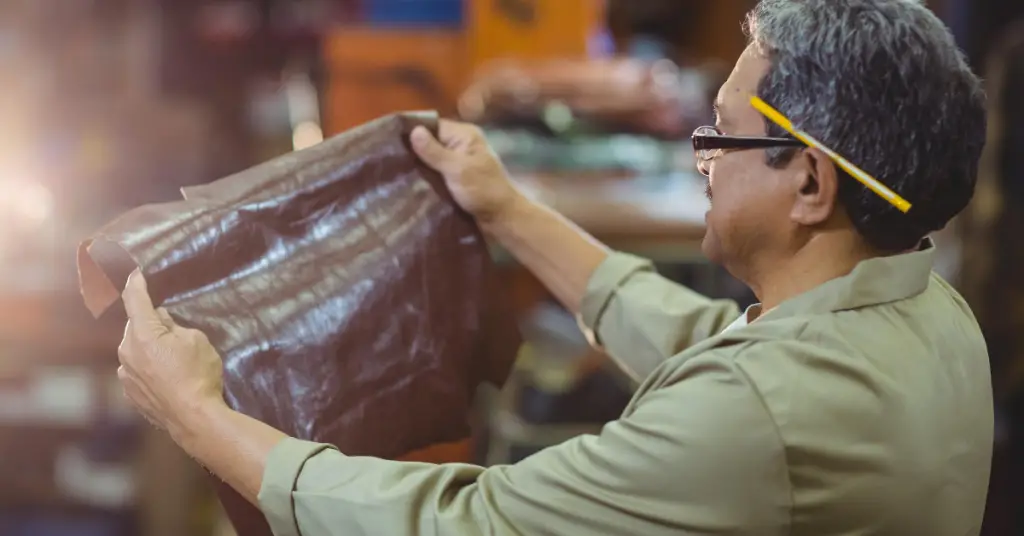For prospective leather couch buyers, knowing the details of the materials used in making their new sofa is important.
Thus, we created this guide to help consumers understand the ins and outs of leather furniture. So, let's start from the beginning.
What Is Leather?
Leather is a natural material made from tanning the hides of animals. Leathers are used for many different products, including car interiors, shoes, and clothing.
While leathers are sourced from many different animals, the most common is from the hides of cattle. As for leather couches, most of the best quality leathers are made from the hides of steer (a male cow), with the leather commonly known as 'steerhide'.
Let's look closer at how leather goes from animal to the products you use in your home.
How Is Leather Made Step By Step?
Leather is made from the skins of various animals, typically those of cows, but can often involve the skins of goats, sheep, snakes and alligators.
The process of creating leather from animal skins (or 'hides') is fairly elaborate. Skins are first washed and treated with chemicals to remove bacteria and hairs, while then undergoing a process known as 'tanning' to strengthen the material and turn it into the leather used in our homes today.
Leather industry insiders say that leather is created as a byproduct of the meat industry, meaning that leftover hides are used. Thus, no new animals are killed to create new leather products.
However, some animal lovers disagree, arguing that animals ARE being killed in order to create leather products. This is a good take on the debate.
Note that industry food trends and what people are eating often dictate what animals are used for leather.
Most leathers are produced from cattle, with the best leather couches utilizing leathers from steer hides (male cows).
I initially learned of some of this information reading some of the posts at the My Furniture Forum, a highly recommended resource.
This article also discusses some of the different types of cattle hides.
Where Is Leather Produced?
Little leather production is done today in the United States (now roughly less than 2% of overall global leather production). The table below is slightly dated and shows overall leather production (along with shoe production).
China, Italy, and Brazil are the top three in terms of worldwide leather production. Note that this involves all types of leathers, thus for leather sofas, it typically comes down to China, Italy, Germany and Belgium.

Just because leather is sourced from China or elsewhere doesn't necessarily mean the associated sofa was also built and assembled there.
Leather is just a raw material that goes into producing leather sofas and other furniture pieces.
I will again recommend a post from the 'My Furniture Forum' where they discuss hide origins.
"Leathers from China are almost all finished hides (painted leather). The Europeans tanneries excel at Aniline hides (Dyed).
The finest hides come out of the north of Germany and Belgium, as the cows are pampered there and the tanneries don't salt the hides for transport, they use refrigerated trucks for transport.
The result being butter-smooth, velvety hides that have big price tags."
What Is The Process Of Tanning Leather?
The process of making leather is both an art and a science, deeply rooted in traditions that span centuries.
At its core, tanning transforms raw hides into durable and versatile material suitable for various applications.
The most common method, vegetable tanning, uses tannins found in plant matter to give the leather its unique characteristics. While this method has been popular for ages, modern tanning methods have expanded to include various techniques tailored to different types of hides and desired finishes.
Leather tanning starts as leftover animal hides from the meat industry that are sent to leather factories (often known as 'tanneries'). These hides are inspected for quality and then brought to the tanning facilities.
During the pre-tanning process, the hides are thrown into large drums, which soak and wash the hides with chemicals and water to wash out salt and hair from the hides.

The animal hides are then removed from the drums as the excess fats are stripped from the backs of the skins. Note that excess fat from hides is commonly used to make bio-fuels and as gelatins for food consumption.
The skins then go back into the drums for the actual tanning process.
What Is Tanning, And Why Is It Used For Leather Production?
Tanning is a key process of leather making and involves taking the pre-treated animal hides and turning them into a more stable material.
Leather tanning prevents rot, stabilizes structure, and improves the leather's resistance to temperature. This is a great paper that discussed more on the science behind tanned leather and why it is necessary for the transformation to end leather products.
This is also a great video from Optimal Leathers, which discusses the tanning and finishing processes of tanned leather.
As shown in the above video, after the first portion of the tanning process is complete, the hides are then re-inserted into the large drums for dyeing and re-tanning.
This step in the process provides the skins with their trademark leather look.
What Types Of Leathers Are Used For Sofas?
While the terminology can often vary, there are four basic types of leather you should be familiar with: Full Top Grain, Top Grain, Genuine Leather and Bonded Leather.
Full "Top Grain" Leather
When I first started researching modern leather types, I was utterly confused.
Let's try to break it down.
When hides go to leather tanneries (where they process hides for leather) they are split horizontally.
Hides are naturally quite thick and on their own wouldn't be suitable as a material for furniture.
When tanners split the hides, the outermost portion is known as the 'Top Grain' with the remainder known as the 'splits'.
The portion of the hide immediately below the hair of the animal is called the 'Full Grain'.
This is named as such since it inherits all of the imperfections and 'grains' of the animal’s hide and are completely undoctored.
Full Top Grain leather is considered to be the highest quality real leather and is very durable.
This chart below is a bit confusing but shows the area near the top of the grain as more structurally sound, whereas when you get near the bottom, or near the 'splits', the hide loses a lot of its durability.

Full Grain leather is also quite smooth, yet can experience some fading over time (although most people pay a premium for this exact effect).
It has a more relaxed look and develops a natural patina over time.
What Is 'Grain' Anyways?
We've mentioned it a few times, and I figured I would just pause to take a break and explain what 'grain' means when discussing leather. In leather circles, grain refers to the surface of the leather and how much it has been corrected. These corrections are done by buffing or sanding out the imperfections on the hides. Thus, when we refer to 'Full Grain' it means that the hide has not been altered in any way. Sometimes, leathers will be referred to as 'Corrected Grain' if the imperfections have been removed. This is where most of the Top Grain leathers will be categorized.
Note that Full Top Grain leathers have no added pigments or protectants and thus can be more susceptible to staining. Full Top Grain leathers represent on average around 4% of the world's leather supplies, thus it is no surprise that these are the most expensive types of leathers.
Top Grain Leather
The next best quality real leather after Full Grain, Top Grain leather is one in which the top grain has been buffed or sanded down. This altering of the surface grains removes any of the imperfections from the leather.
Sometimes Top Grain leathers can be called 'Corrected Grain' leathers. These are more widely available from tanneries and are less expensive than Full Grain leathers.
It is also more durable than Full Grain leather. Top Grain leather is one of the more common leathers used for good quality leather furniture.
Genuine Leather
Genuine leather is made from the 'splits' on the hide; remember that tanneries will separate the animal hide into different materials, notably a 'top grain' and the splits, which are the inferior structure of the hide.
The splits are combined with numerous chemicals (often plastics!) to create the look of a more expensive leather artificially.
While it can sometimes look pretty good, we would not recommend purchasing any genuine leather made couches.
Genuine leather is made up from the scraps of the hide and is prone to cracking.
Bonded Leather (also known as Bicast Leather)
This is generally the lowest grade of leather, although many countries cannot refer to bicast (aka as 'bycast') or bonded leather as actual leather.
Bonded leather comprises ground-up chunks of leather (typically the scraps at the leather factory) and is glued back together.
Bonded leather does not have the typical structure of authentic leather and is compared to particle board in the furniture world.
It is certainly the most inexpensive type of 'leather,' and if consumers can afford a true top grain or full grain leather sofa, we recommend against a bonded leather sofa every time.
Pros are that it is much cheaper than genuine leather but the material is not very durable.
Can Leather Be Made Without Killing Animals?
Yes, leather for sofas can be made without killing animals. However, most will not have the same quality and durability as traditional leather.
The most common alternative today is known as 'Vegan Leather', however, it is far inferior to genuine leather.

A West Elm Vegan Leather Sofa
Vegan Leather sofas are made from synthetic materials such as plastic polyurethane mixtures and ultimately will not last nearly as long as a real leather sofa.
Are Exotic Animals Used To Make Furniture?
Leather isn't just limited to the byproducts of the dairy industry or common livestock. Exotic leather, sourced from unique animals like ostrich skin, kangaroo, and buffalo, offers distinct textures and patterns that are highly sought after in the fashion world.
However, most exotic animal leathers are not used to make everyday furniture.
Kangaroo leather, for instance, is prized for its lightweight yet strong properties, making it a popular choice for premium sports equipment and luxury goods.
Similarly, chamois leather, originally derived from the European mountain goat but now often sourced from other animals, stands out for its supple feel and is commonly used in gloves, bags, and cleaning cloths.
While exotic leathers provide unique aesthetic qualities, they also raise ethical considerations, given their sourcing from exotic animals.
What are the disadvantages of leather furniture?
Leather sofas are popular for their modern appearance and longevity, but they come with several disadvantages. Here are some of the potential downsides to consider when thinking about purchasing a leather sofa:
- Cost: Genuine leather sofas are typically more expensive than their fabric counterparts.
- Maintenance: Leather requires regular care to keep it looking its best. This includes wiping with a soft cloth, avoiding direct sunlight (which can fade and weaken the material), and occasionally conditioning the leather to prevent drying and cracking.
- Susceptible to Scratches: Leather can be easily scratched, especially softer varieties. Over time, this can affect the appearance of the sofa.
- Temperature Sensitivity: Leather can feel cold in winter and may become uncomfortably warm or sticky in summer. This temperature sensitivity can make it less comfortable in extreme climates or homes without consistent climate control.
- Potential Cracking: Without proper care, leather can dry out and crack over time.
- Limited Styles and Colors: Leather sofas might not be available in as wide a range of colors or patterns compared to fabric sofas.
- Not Pet-Friendly: Leather can be easily damaged by pets, especially by their nails or if they have an accident.
- Allergy Concerns: While leather itself is not commonly an allergen, the dyes and chemicals used in tanned leather can trigger allergic reactions in sensitive individuals.
- Ethical and Environmental Concerns: Some individuals avoid leather products due to concerns about animal welfare and the environmental impact of leather production.
- Absorbs Odors: Leather can absorb odors more easily than some other materials. This can be problematic if the sofa is exposed to cigarette smoke, pet odors, or other strong smells.
- Can Feel Slippery: The smooth surface of soft leather can sometimes feel slippery, making it less stable to sit on compared to some fabric sofas.
- Fading: If exposed to direct sunlight for prolonged periods, leather can fade and lose its vibrant color.

